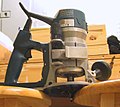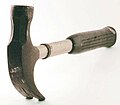AY Honors/Carpentry/Answer Key
Carpentry
1. Describe the function of the following tools:
- Bandsaw.jpg
Heavy Duty Bandsaw
- Radialarmsaw.jpg
Radial Arm Saw
- Standard Shaper.jpg
Shaper
Band Saw
A band saw is a saw that can be used for woodworking, metal working, and a variety of other materials. It gets its name from its blade, consisting of a narrow band of toothed metal. This band rides on two large wheels stacked vertically with a space between them. Band saws are particularly useful for cutting irregular shapes. The radius of a curve that can be cut on a particular saw is determined by the width of the band.
Belt Sander
A belt sander is a machine used to quickly sand down wood and other materials for finishing purposes. It consists of a motor that turns a pair of drums on which a seamless loop of sandpaper is mounted. Belt sanders can be either hand-held, where the sander is moved over the material, or stationary (fixed), where the material is moved to the sanding belt. Stationary belt sanders are often combined with a disc sander.
Belt sanders can have a very aggressive action on wood and are normally used only for the beginning stages of the sanding process, or used to rapidly remove material.
Jig Saw
A jigsaw (also called saber saw or sabre saw) is a type of saw used for cutting arbitrary curves, such as stenciled designs or other custom shapes, into a piece of wood or similar material. It is usually used in a more artistic fashion than other saws, which only cut in straight lines and exist mainly to chop pieces of wood to length for building structure. The first jigsaw puzzles were made using this kind of saw.
Traditional jigsaws are hand saws, consisting of a handle attached to a small, thin blade. More modern jigsaws are power tools, made up f a motor and a reciprocating saw blade.
Miter Saw
Today, a miter saw (also called a chop saw or drop saw) usually refers to a power tool used to make a quick, accurate crosscut in a workpiece. It is most frequently used to cut wood, although some plastics and light metals can also be cut with the tool. Common uses include framing operations and the cutting moulding. Most miter saws are relatively small and portable, with common blade sizes ranging from eight to 12 inches.
The miter saw makes cuts by pulling a spinning circular saw blade down onto a workpiece in a short, controlled motion. The workpiece is typically held against a fence, which provides a precise cutting angle between the blade and the longest workpiece edge. In standard position, this angle is fixed at 90°.
Radial Arm Saw
A radial arm saw is a machine intended for cutting materials to length. It is primarily a woodworking machine, although it is sometimes used for cutting metals, such as angle iron or aluminum extrusions. Before the advent of the radial arm saw, table saws and hand saws were most commonly used for crosscutting lumber. Table saws are ideal for ripping stock, but it is awkward to push a long piece of stock widthwise through a table saw blade. When a radial arm saw is used, the stock remains stationary on the saw's table and the blade is pulled through the stock.
Router
A router is a woodworking tool used to route out (hollow out) an area in the face of a piece of wood. It was a tool particularly used by pattern makers and consisted of a broad-based wooden hand plane with a narrow blade projecting well beyond its base plate. Since about 1960, it has been replaced by the modern spindle router, which was designed for the same work. Further refinement has produced the even more recent plunging spindle router, which is even better adapted for many types of work.
Shaper
A wood shaper is a stationary woodworking machine in which a spindle spins at moderately high speeds. Specially shaped bits are mounted on the spindle. As the workpiece is fed into the machine, the bit cuts a profile into it. On some shapers, router bits can also be used using a special mounting adapter.
Wood shapers do essentially the same job as the router table, with the main difference being that a wood shaper is a stationary machine designed for larger volume work while a router table is a hand tool for lighter duty work. Routers can also be mounted on a router table, and used as a stationary tool. However, routers run at considerably higher speeds than shapers, and the use of large bits can be dangerous. Also, shapers can be used to cut much larger profiles than routers and custom-made shaper bits can be readily ordered or fabricated.
2. Demonstrate how to use the following tools:
- Dewalt circular saw.jpeg
Circular Saw
- Level1.jpg
Level
- Nail set.jpg
Nail Set
- PlumbBob.jpg
Plumb Bob
Block Plane
A block plane is designed to cut end grain and is typically small enough to be used with one hand. To use it, securely clamp the piece to be planed to a solid object (ideally, a work bench). Then pass the plane's sole across its surface. The blade can be adjusted, and it is best to set it such that the blade barely protrudes out of the bottom of the plane. It is best to take very thin shavings. If no wood is removed, let the blade out a little more.
Circular Saw (cut a straight line)
Framing Square
Hammer
Grip the hammer near the end of the handle opposite the hammer's head. Many people grip the handle near the hammer's head, but this is incorrect. When driving a nail, the hammer must be maneuvered so that its flat face strikes the nail's head at a right angle to the nail's axis, with the head moving parallel to that axis. Failure to achieve either condition will result in a sideways force on the nail's head, that may bend it. Also, one should relax the muscles of the hand and arm momentarily when the hammer strikes.
Hand Saw (cut a straight line)
Level
Measuring Tape
Nail Set
Plumb Bob
Wood Chisel
== 3. Describe the use of and distinguish between the following types of nails: 20 Penny, 16 Penny, 12 Penny, 8 Penny, 6 Penny, Finish, Brad, Roofing, Screw Nail, Sinker, Common, and Galvenized ==
The Penny designation specifies a nail's size. The higher the penny number, the larger the nail.
4. Assist in Erecting a building not less than 6x8 feet in ground dimensions with a gable roof and at least one door and one window, demonstrating ability to measure and use tools from requirement 2.
This module has many different areas to consider.
- Safety
- Safety is your responability.
- Safety on the Job site.
- Safety for the other people around you
- Enviromental safety.
- PPE (Personal Protection Equipment)
- What is PPE Personal Protection Equipment?
- Things to think about when buying PPE
- Codes and regulation about PPE
- OSHA regulations
- Tools selection
- Materials selection and inspection
- Blue print reading
- Basic construction
- Building codes
- Permits
- Building inspections
- Understanding other construction that effect your task or yours effecting the next task
5. When building the above project, use all of these features:
Floor Joist
Sub Floor
Shoe Plate
Top Plate
Double Plate
Conventional Roof or Trusses
Felt Roof
Shingles
Window with Weight-bearing Header
Door with Weight-bearing Header
Fascia on Eaves
Siding
Note
Participants must be 16 years old or older to use power tools.
References
Much of the material in this section was taken from the Wikipedia article on the various tools presented here.








